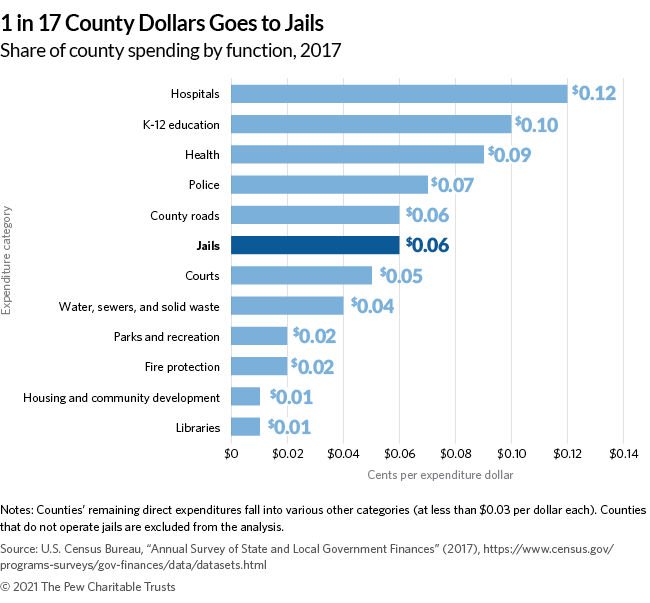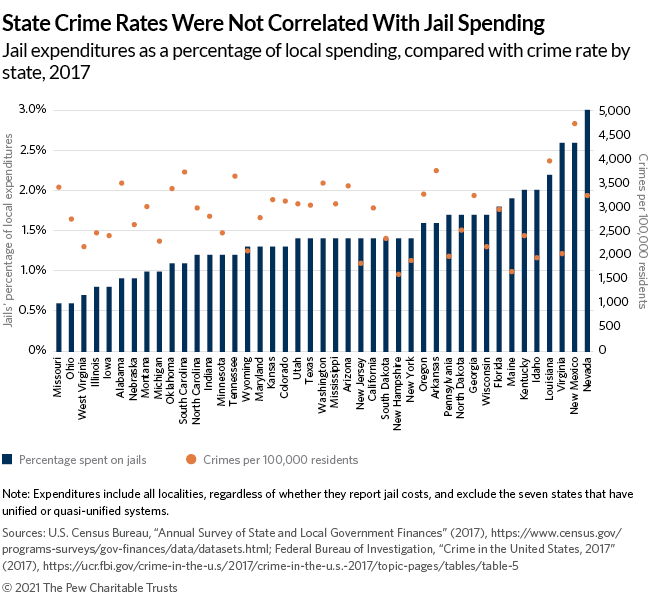Jail Costs Strain Local Budgets Even as Crime Falls
In 2015, the City of Philadelphia—where I led the Safety and Justice Challenge through 2019—contemplated replacing a jail that was more than a century old. But following a public outcry against building an expensive new facility, and thanks to concerted efforts by government agencies and community advocates working to reduce the level of incarceration in the city, Philadelphia was able to close the existing jail in 2018 without building a replacement—because the jail population had fallen significantly since historic highs in 2012.
As many cities, counties, and states face significant budget pressures as a result of the pandemic, spending on jails is receiving increased attention. The cost of these facilities has grown 13% over the last decade, despite falling crime and fewer people being admitted to jail. Spending on jails far outpaces many other vital services, such as fire protection, housing and community development, and libraries. About 1 in 17 county dollars nationwide is targeted for incarceration costs, with jails among the top six cost-drivers for the average county.
The Pew Charitable Trusts recently examined expenditure data for all U.S. localities and undertook an analysis of jail costs, primarily from 2007 and 2017, when jail spending could be disaggregated from the relatively small amount of other costs at local jails. We found that local corrections costs rose sixfold between 1977 and 2017.
These rising jail costs have occurred even though 2 million fewer crimes were reported to law enforcement in 2017 than in 2007. During that same period, jail admissions dropped 19%, from 13.1 million to 10.6 million, while the average daily jail population remained relatively flat, declining only 4%, or by 27,500 people. The gap between the change in admissions and population is because of rising average lengths of stay between 2007 and 2017.
Jail costs can rise for a variety of reasons. Growing populations lead to an increase in variable costs, such as utilities, but jails also carry sizeable fixed costs because of their physical footprint and staffing requirements—regardless of how full a facility may be. Counties with older jails may have to contend with frequent repairs or the prospect of replacing a deteriorating building with a new facility, an expense that can cost hundreds of millions of dollars. And the growing number of people with behavioral health and substance use issues in jails can contribute to escalating health care costs, which can eat up 1 in 3 correctional dollars.
And although people typically equate spending more on jails with safer communities, the numbers don’t bear that out. Pew found that increased spending on jails as a percentage of local budgets did not correlate with state crime rates:
A recent Vera Institute report on large city jails showed that safely reducing jail populations can be an effective way for local jurisdictions to curb incarceration costs. Of the jails in the study, almost half of those that cut their population by at least 30% since 2011 were able to decrease their spending. All but one of the jails that increased their population saw increased costs. Philadelphia was one of those cities that decreased its population by 45% and was able to achieve an 18% reduction in jail expenditures. And public officials can expand policies implemented during the pandemic—which have proved effective in lowering jail populations—to continue to downsize their jail systems even when COVID-19 is no longer a threat.
The data is clear and suggests a solution that can satisfy those with fiscal and safety concerns alike. By continuing and strengthening efforts to reduce jail populations, policymakers can make more effective use of public safety dollars while keeping communities safe.
Julie Wertheimer directs the public safety performance project at The Pew Charitable Trusts.
This piece was originally published by Safety and Justice Challenge on May 5, 2021.















